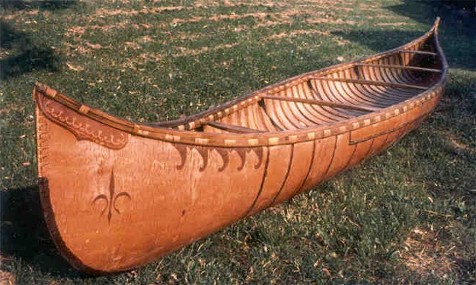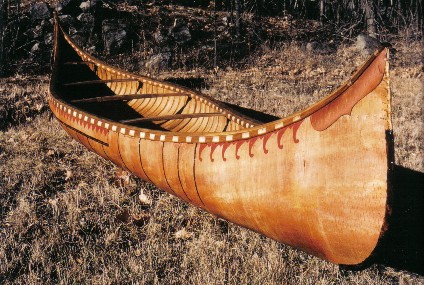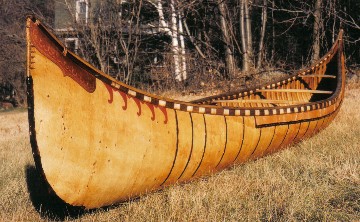|
St. Lawrence River Malecite birch bark canoe with flare sides |
Old style Malecite birch bark canoe with tumblehome sides |
||
|
|
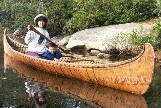 |
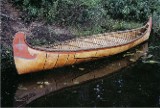 |
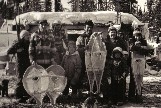 |
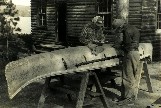 |
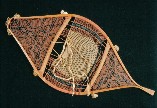 |
| Full size birchbark canoes | Scale model birchbark canoes | Native technology videos and DVDs | Native technology books | |
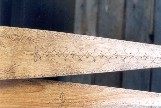 |
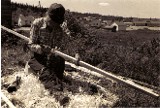 |
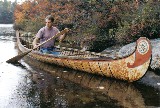 |
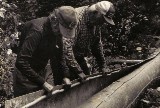 |
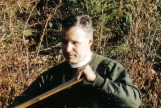 |
| Traditional paddles | Crooked knives | Home |
Materials |
About the builder |
| A Brief Historical
Background
|
|
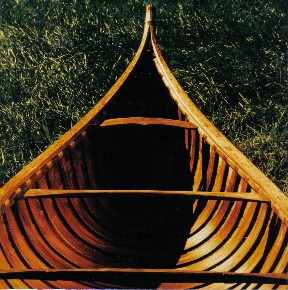 |
The birchbark canoes of the Malecite , Penobscot , and Passamaquoddy [ hereinafter collectively referred to as Malecite ] were perhaps most noteworthy for the refinement of their construction, Although individual builders from other tribes sometimes matched or surpassed their work , the Malecite set a high standard in the precision of the wood framing and bark skins of their canoes that distinguished them as some of the finest boat builders in North America . And a good number of their canoes featured painted or "winter bark'' decoration that gave them a sometimes striking appearance. |
| Interior view of 14' flare-sided St. Lawrence River type Malecite birch bark canoe. | |
| The earlier form of birchbark canoe used by these tribes featured a tumblehome sided hull with a rather high peaked bow profile. In the mid 1800's , a variant form with a flare -sided hull developed in the St. Lawrence River region of Quebec; this type was most likely a hydrid based on the flare sided canoe forms that predominated to the north and west of the Malecite .Elsewhere throughout Malecite territory, the ancient high ended ,tumblehomed canoe had been replaced with a lower ended type with a much more rounded bow profile by the end of the 19 th century. The reasons for the change in form are unclear. At the time , sawn wood [spruce ] was being used with great frequency for the gunnels of canoes , and the lower bow would have been easier to construct with this material. The split and shaved cedar used in the past could be bent to any height without difficulty , whereas sawn spruce was much more unyielding . There was also a tendency during the decline of tradtional Native cultures to eliminate features that were more aesthetic than practical. |
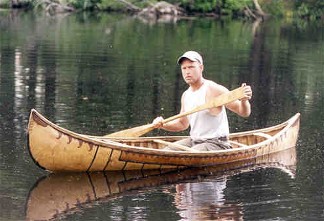 |
| A 10' St. Lawrence River Malecite type birch bark canoe. |
 |
From this lower ended version
was developed the modern canoe as we know it today, The great names in canoe
manufacturing - E.M.White, Gerrish , Morris and Old Town - took their
inspiration from the birchbark canoes of their native Maine . The earlier
versions of their wood and canvas craft featured many details of construction
that were identical to their birchbark parent . In later years , these details
were modified for the sake of more expedient assembly .But what remained was a
form that was true to the Indian canoe that had served so well for hundreds ,
and perhaps thousands of years before the arrival of Europeans in North
America
|
| Double curve motif etched in a ''winter bark'' deck for a St. Lawrence River Malecite type birch bark canoe |
| Available Sizes and
Models
The flare sided St. Lawrence River birchbark canoe |
|
| This type of can be made in
lengths from 10' to 20' ; the usual beam is 34'' with an average depth of
12'', although wider and deeper canoes , as well as narrower models can be
made .The 10' and 12' sizes are primarily one person canoes , while the larger
canoes will accomodate 2 or more people.
Flare sided canoes provide greater carrying capacity relative to hull weight than tumblehome sided models. The spreading of the gunnels at the top increases displacement , and this characteristic predominates in the birchbark canoes found throughout North America . The huge cargo canoes of the French fur trade with their strongly flared sides are good examples of this type. |
 |
| A flare sided 14' St. Lawrence River Malecite birchbark canoe | |
|
|
Decoration consists of etchings in the 'winter-bark' of the deck flaps at the top of the bow and stern; the traditional ''double-curve'' motif of the northeastern tribes is most often used here. The side panels [the pieces of bark sewn to the main bark sheet to gain the necessary width ] if needed,can also be decorated with winter bark etchings , or painted in period colors. Here the'' double curve'' can again be used as well as other motifs such as the ''fiddlehead'' pattern.The crossbars of Malecite canoes ,particularly those in the center , are also often decorative in their shapes, and add to the grace of the craft. |
| An 18' tumblehome-sided Malecite birchbark canoe of standard proportion; beam 31 1/2 ''. In a canoe very much like this one , Henry David Thoreau travelled in the Maine woods with Penobscot guides in the mid 1800's. | |
| The tumblehome sided birchbark canoes. These canoes are availble in lengths from 12' to 20' , with average beams of 32'' and depths of 12''.The most commom sizes in use among these tribes ranged from 16' to 20' , with the 18' model being the most popular. It was in 18' and 19' birchbark canoes that Henry David Thoreau travelled with his Penobscot guides during his trips to the Maine woods in the mid 1800's. The decoration and other details of these canoes follows that described for the flare sided type |
|
[TOP]
For more information not included on this website
email
henri5@birchbarkcanoe.net
phone 603-878-3616
or write Henri Vaillancourt
PO Box 142
Greenville, New Hampshire, 03048
